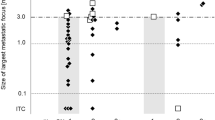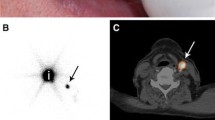Abstract
The aim of the study was to evaluate sentinel lymph node size as a predictor of metastasis in N0 patients with oral squamous cell carcinoma treated by individual sentinel node biopsy (SNB) guided neck dissection. In addition, to evaluate lymph node shape as an indicator of malignancy. A retrospective study based on data from 50 patients with clinically N0 neck and oral squamous cell carcinoma stage T1-2N0M0, SNB and consecutive neck dissection was performed. Excised sentinel nodes were measured in three axes by the surgeons before undergoing histopathological examination. Measured sentinel node axis lengths were compared with the histopathological results. Data were analysed using Microsoft Excel 2008 for Mac, version 12.0. A total of 167 sentinel nodes was excised with a median of 3.3 per patient. Following SNB 18% of the patients was upstaged at the subsequent histopathological examination. This correlates to 7% of the total number of sentinel nodes. The diameters of all three axes were compared for both negative and positive nodes. The positive nodes were not significantly larger. The sensitivity and specificity of lymph node size as a criterion for staging were calculated at several thresholds. There was no tendency that lymph node shape changed towards spherical when positive for metastases. There is a tendency that the risk of metastases and upstaging increases with increasing maximum and partly minimum diameter. However, in this study it was not possible to establish a suitable threshold level with both high sensitivity and specificity based on size and shape. Other features of the lymph node must be considered if an accurate staging of N0 patients is to be performed.

Similar content being viewed by others
References
Bilde A, Von Buchwald C, Johansen J et al (2006) The Danish national guidelines for treatment of oral squamous cell carcinoma. Acta Oncol 45:294–299
von Buchwald C, Bilde A, Shoaib T et al (2002) Sentinel node biopsy: the technique and the feasibility in head and neck cancer. ORL J otorhinolaryngol Relat Spec 64:268–274
Ross G (2004) Rationale for sentinel node biopsy to stage N0 head and neck squamous-cell carcinoma. Cancer Biother Radiopharm 19:273–284
Khafif A, Schneebaum S, Fliss DM et al (2006) Lymphoscintigraphy for sentinel node mapping using a hybrid single photon emission CT (SPECT)/CT system in oral cavity squamous cell carcinoma. Head Neck 28:874–879
Rigual N, Douglas W, Lamonica D et al (2005) Sentinel lymph node biopsy: a rational approach for staging T2N0 oral cancer. Laryngoscope 115:2217–2220
Alkureishi LW, Ross GL, MacDonald DG et al (2007) Sentinel node in head and neck cancer: use of size criterion to upstage the no neck in head and neck squamous cell carcinoma. Head Neck 29:95–103
Garcia Callejo FJ, Dualde Beltran D, Benlloch Ramos E et al (2008) Use of imaging criteria to identify cervical metastases using CT scans in head and neck tumours. Acta Otorrinolaringol Esp 59:257–262
Hohlweg-Majert B, Metzger MC, Voss PJ et al (2009) Preoperative cervical lymph node size evaluation in patients with malignant head/neck tumors: comparison between ultrasound and computer tomography. J Cancer Res Clin Oncol 135:753–759
Layland MK, Sessions DG, Lenox J (2005) The influence of lymph node metastasis in the treatment of squamous cell carcinoma of the oral cavity, oropharynx, larynx, and hypopharynx: N0 versus N+. Laryngoscope 115:629–639
Som PM (1992) Detection of metastasis in cervical lymph nodes: CT and MR criteria and differential diagnosis. AJR Am J Roentgenol 158:961–969
Brazilian Head and Neck Cancer Study Group (1999) End results of a prospective trial on elective lateral neck dissection vs type III modified radical neck dissection in the management of supraglottic and transglottic carcinomas. Head Neck 21:694–702
Bilde A, von Buchwald C, Therkildsen MH et al (2008) Need for intensive histopathologic analysis to determine lymph node metastases when using sentinel node biopsy in oral cancer. Laryngoscope 118:408–414
Hermanek P, Hutter VR, Sobin HL et al (1999) International union against cancer. Classification of isolated tumor cells and micrometastasis. Cancer 86:2668–2673
Christensen A, Bilde A, Therkildsen MH et al (2011) The prevalence of occult metastases in nonsentinel lymph nodes after step-serial sectioning and immunohistochemistry in cN0 oral squamous cell carcinoma. Laryngoscope 121:294–298
van den Brekel MW, Stel HV, Castelijns JA et al (1990) Cervical lymph node metastasis: assessment of radiologic criteria. Radiology 177:379–384
Som PM, Curtin HD, Mancuso AA (2000) The new imaging-based classification for describing the location of lymph nodes in the neck with particular regard to cervical lymph nodes in relation to cancer of the larynx. ORL J Otorhinolaryngol Relat Spec 62:186–198
Schöder H, Yeung HW, Gonen M et al (2004) Head and neck cancer: clinical usefulness and accuracy of PET/CT image fusion. Radiology 231:65–72
Shah GV, Fischbein NJ, Gandhi D et al (2004) Dynamic contrast-enhanced MR Imaging. Top Magn Reson Imaging 15:71–77
Yonetsu K, Sumi M, Izumi M et al (2001) Contribution of Doppler sonography blood flow information to the diagnosis of metastatic cervical nodes in patients with head and neck cancer: assessment in relation to anatomic levels of the neck. AJNR Am J Neuroradiol 22:163–169
Alkureishi LW, Burak Z, Alvarez JA et al (2009) Joint practice guidelines for radionuclide lymphoscintigraphy for sentinel node localization in oral/oropharyngeal squamous cell carcinoma. Ann Surg Oncol 16:3190–3210
Flach GB, Broglie MA, van Schie A et al (2012) Sentinel node biopsy for oral and oropharyngeal squamous cell carcinoma in the previously treated neck. Oral Oncol 48(1):85–89
Conflict of Interest
There is no conflict of interest. None of the authors have a financial interest in the research and it is done without any financial support.
Author information
Authors and Affiliations
Corresponding author
Rights and permissions
About this article
Cite this article
Langhans, L., Bilde, A., Charabi, B. et al. Evaluation of sentinel lymph node size and shape as a predictor of occult metastasis in patients with squamous cell carcinoma of the oral cavity. Eur Arch Otorhinolaryngol 270, 249–254 (2013). https://doi.org/10.1007/s00405-012-1959-x
Received:
Accepted:
Published:
Issue Date:
DOI: https://doi.org/10.1007/s00405-012-1959-x




